
Table of Contents
- Introduction
- Important Aspects of Social Media Management
- Who is a Social Media Manager?
- Top social media platforms
- Social Media Management Tools: Some Best Options
- Take a look at your current social media approach: Audit
- Identifying your target market
- Selecting social media platforms
- Putting together your social media plan
- Making your social media profiles look good
- Creating social media advertisements
- Creating a content calendar for social media
- Creating social media content tailored to a given
platform - Responding to messages on social media
- Keeping an eye on your social media performance
- Costs Involved In Social Media Management
- How Does Social Media Management Help Your Business?
- Conclusion
Introduction
A few years ago, social media was seen solely as a hub for high school students. Today, it has a huge impact on how people of all ages obtain and share information throughout the world.
In all of its forms, social media has undeniably transformed the world. It has brought individuals from all over the world together in discussions about their common interests.
Social media presents a great opportunity for businesses as well. It’s more crucial than ever to interact with your audience on social media. Customers interact with brands on social media sites such as Twitter, Facebook, Instagram, and others, and they expect prompt responses and professional solutions.
That is where social media management found its roots. Businesses need to stay up to date on their social media handles to attract customers, and for that purpose, they require proper and strategic management of their social media accounts.
We will be discussing all the aspects of social media management and how to manage social media effectively in this article to make you familiar with the concept in detail. Let’s dive right in.
Important Aspects of Social Media Management
In simple terms, social media management is planning and executing a branding strategy meant for a social media platform that helps brands build and engage an online audience, foster better customer relationships, humanize their business, and drive more sales.
When your business focuses on building a brand strategy following the demands of the varied social media platforms available, it can generate more leads and paying customers and help improve brand loyalty. In short, greater profits are what awaits at the end of an effective brand strategy.
Here are some important aspects of social media management.
Scheduling Posts in advance
Ensuring that your audience sees your content consistently increases the chances of engagement, brand awareness, referral traffic, and conversions. Scheduling your social media posts allows you to share them at the right time when you know people are interacting with your content the most. Planning this strategy is not as easy as many people think. It involves user research, competitor analysis, trend studies, campaign ideation, content ideation, contest preparation, etc. Moreover, planning is not a one-time activity. It is ongoing. You cannot plan for a month today and expect the same strategy to work for you in the coming months.
Managing Multiple Social Media Accounts
It’s difficult to keep track of multiple social media pages. You don’t want to inadvertently cause a public relations disaster by posting something on the wrong page.
Thankfully, the correct tools may greatly simplify the process of social media handling. It’s a big time-saver to have everything in one social dashboard.
If you use an effective social media managing tool, you may also work on all of your social profiles from a desktop or laptop computer.

Social Engagement Analysis
Figuring out how much and how often audience accounts interact with your account is the goal of engagement analysis. High engagement rates reflect audience quality (how proactive the audience has been and how many of your followers are “genuine”) and what type of content is performing the best.
Efficiently Engaging with Comments
Engaging with the audience and replying to social media comments, whether positive or negative, is an important part of managing social media accounts.
Positive comments are fantastic since they allow you to reach customers and develop a reputation. Negative comments allow you to correct errors and make amends, making customers feel good about the brand and encouraging them to return.
Collaborating to Create Content
Collaborating with businesses relevant to your own can result in massive rewards for everyone involved. When two brands collaborate to create content that resonates with both of their audiences, it is referred to as collaborative content. Each brand gains visibility and access to the audience of the other.
Gaining Access to Exhaustive Analytics
Social media analytics can assist you in answering the all-important issue of whether or not your social media plan and strategy are working.
The following are the main advantages of using social media analytics:
- Illustrate your return on investment
- Build successful social media campaigns
- Compare yourself to your competitors.
- Determine what topics are currently popular.
Influencer Partnerships
Look for social media influencers with similar audiences to yours and form ties with the individual behind the brand.
You can approach them by offering to send your products for sharing reviews online. You can also collaborate with the influencers to create engaging and original content around your brand and product.
To add to all of this, social media is where the ‘creative bent of mind’ plays a major role. Surviving the cutthroat competition can get tough if you are not creative enough. This is where hiring a social media manager can lend a hand.
Who is a Social Media Manager?
A social media manager is the individual who is responsible for helping your brand achieve its social media goals and objectives. This certain individual can either be a freelancer, an in-house team member or it could be an entire social media agency.
One thing that you must know is that not all social media managers can handle every aspect of the process.
A social media manager majorly creates a strategy, develops a calendar, ensures content is scheduled and published per that calendar, engages with the audience, analyzes reports, and helps you meet your goals.
There are chances that copywriters and graphic designers take over the part concerned with content creation. This is especially true in the case of a social media agency.
However, if there is a one-person social media manager, they are responsible for everything, from strategizing to creating content to publishing it.
Here is a list of top social media platforms that social media managers usually handle all at once:
Top social media platforms
| Social media platforms | Number of monthly active users | Age Demographics |
|---|---|---|
| 2.7 billion | 25 to 34 years | |
| YouTube | 2 billion | 15 to 25 years |
| 1 billion | 25 to 34 years | |
| 738 million | 46 to 55 years | |
| 400+ million | 30 to 49 years | |
| Snapchat | 265 million | 13 to 34 years |
| 187 million | 30 to 49 years | |
| TikTok | 100 million | 18 to 24 years |
As we can see from the table above, the top eight social media platforms are being used in today’s time and date. Let us take a look at each one of them below.

Facebook is the most popular social media platform with the highest number of active users. For the general public, Facebook is a great platform to stay connected with the life updates of their family members and friends.
This also makes them spend the most time on the platform as compared to others available at their disposal. It is one of the many reasons why small businesses can leverage Facebook to promote their products or services.
Purpose
- Engaging with the audience and building better customer relationships.
- Building a following for your business.
Best time to post
- According to Buffer, the best time to post on Facebook is between 1 PM and 3 PM on weekdays and Saturdays.
- According to Hubspot, the best time to post on Facebook is between 1 PM and 3 PM on Thursdays and Fridays.
- According to Coschedule, the best time to post on Facebook is between 1 PM and 4 PM on Thursdays, Fridays, Saturdays, and Sundays.
YouTube

After Facebook, YouTube is the second most popular social media platform, with approximately 2 billion active users. YouTube is the original platform that made videos famous, from creating to watching them. Today, over four billion videos are being watched by users every single day.
This is one platform that has attracted and engaged users from all demographics. Whether it’s a 65-year-old or a 5-year-old, both the age groups can be seen using and enjoying the platform, all thanks to the availability of varied genres.
Additionally, with video marketing gaining the fame it deserves in recent years, more brands are also investing their time, efforts, and money into the platform.
Purpose
- Reaching your potential customers.
- Giving your SEO efforts and organic marketing strategies a boost.
Best time to post
According to Oberlo, the best time to post on YouTube is between 2 PM and 4 PM on Thursdays and Fridays. The afternoon is when your videos get the best number of views and attention.

While most Instagram users spend their time sharing photos and videos on the platform, a new feature was rolled out by the platform that has turned it into a business magnet.
This feature is an Instagram shop, where businesses can post photos of their products, tag their costs, and link them to a landing page where customers can make the final purchase.
Purpose
- Sharing photos and videos that are visually appealing.
- Spreading brand awareness.
Best time to post
According to HubSpot, the best time to post on Instagram is between 11 AM and 2 PM on weekdays.

Primarily used by HRs to find new candidates for their companies and job seekers to find relevant job offers, LinkedIn has now come a long way.
Today, LinkedIn is no longer just a job-seeking platform. It has become a professional networking vehicle, allowing professionals in the same field but different corners of the globe to connect.
This is the platform where you can showcase your skills, work, and connect with other businesses in your industry.
Purpose
- Find job opportunities and candidates.
- Find freelance work or clients for service-based businesses.
- Showcase your work and skills.
- Connect with other business professionals in your field of work or those related to your industry.
Best time to post
According to HubSpot, the best time to post on LinkedIn is between 8 AM and 2 PM from Tuesdays to Thursdays. It is best to avoid weekend and out-of-business hours to post on this platform.

Pinterest is nothing short of a really attractive and visually appealing scrapbook. This platform is similar to an online pinboard, where users can search for various inspirations for recipes, fashion, painting, designs, and a lot more.
This platform can be a great way for businesses to generate website traffic. For instance, suppose you sell clothes. You can share a picture of an outfit created out of clothes you sell, share it on Pinterest, and add a link to your website/eCommerce store.
However, this should be done only if you have your target audience on the platform.
Purpose
- Increasing the overall website traffic.
- Enhancing brand exposure.
- Expanding the brand reach.
Best time to post
The best time to post on Pinterest is either between 8 PM and 11 PM, or 2 AM and 4 AM on Fridays and Saturdays.
Snapchat

Next in line comes Snapchat. If you are selling products or services to younger audiences, Snapchat is where you should pitch your tent.
This platform is most popular among teenagers that love spending their time creating content for the world to see. This is a platform that most businesses use during influencer collaborations or takeovers and when exclusive offers are being launched.
Purpose
- Extremely useful to showcase the brand’s human side by sharing behind-the-scenes videos.
- To conduct influencer marketing, including takeovers and collaborations.
Best time to post
According to Amplifr, the best time to post on Snapchat is between 10 PM and 1 AM on all days of the week.

Twitter is a gold mine. This platform has quickly become one of the platforms where brands can get recognized. The catch here is that this recognition doesn’t always mean it’ll be positive.
Many users use this platform to share positive and negative experiences with a brand. Or they also use it to engage in conversations with brands, making the business sound human and personal.
Apart from that, Twitter is also a platform where the news spreads faster. It is a platform where users don’t shy away from speaking their minds. Since the content is limited to 280 characters, the Tweets are pretty snackable, making it appropriate for this fast-paced world.
Purpose
- A great platform to indulge in social listening and make customer relations better.
- Makes it easier to share valuable knowledge with the audience.
Best time to post
According to Sprout Social, the best time to post on Twitter is between 9 AM and 3 PM on Wednesdays and between 9 AM to 11 PM on Tuesdays and Thursdays.
Tiktok
TikTok is the latest but fastest-growing social media platform. The growth that TikTok has witnessed certainly broke some records. This platform has exceeded Facebook in terms of the app on which users spend most of their time.
This platform has combined two important aspects of social media – videos and a short time span. In this fast-paced world, taking out time is challenging. That’s where short-form videos, optimized for mobile phones, have become popular.
This is a perfect platform for those looking to connect with Gen Z.
Purpose
- Spreading brand awareness and gaining a loyal following.
- Advertise brands with the help of authentic ads and behind the scenes.
- Conduct influencer takeovers and collaborations.
Best time to post
According to Oberlo, the best time to post on TikTok varies with the days.
Monday: 6 AM / 10 AM / 10 PM
Tuesday: 2 AM / 4 AM / 9 AM
Wednesday: 7 AM / 8 AM / 11 AM
Thursday: 9 AM / 12 PM / 7 PM
Friday: 5 AM / 1 PM / 3 PM
Saturday: 11 AM / 7 PM / 8 PM
Sunday: 7 AM / 8 AM / 4 PM
These are the top social media platforms that are available in today’s day and age. Every platform has its own set of pros and cons. To make sure that the balance is maintained between the two is why social media management is crucial.
Social Media Management Tools: Some Best Options
Thanks to technological advancement, social media management was simplified and, consequently, has become less time-consuming.
Some tools can manage different aspects of social media, ranging from creating quality content to scheduling it, from finding what the customers are talking about your brand to monitoring the performance of your efforts.
Below are some of the top tools available in the market for you to explore.
(Disclaimer: The list goes beyond the tools mentioned below. This list is of our top picks; feel free to explore more options before settling down for a tool.)
Content Ideation

When figuring out your campaign reaches a roadblock, there are tools that can help you out.
-
BuzzSumo
This is a great tool for you to leverage research and move on from guesswork. The tool scans billions of articles and social media content across industries to bring you the trending topics, allowing you to create data-backed content.
-
Answer The Public
This tool compiles all the searches that are being searched on Google and instantly provides you with all the useful keywords and questions that users are asking. You can ideate your campaigns based on the information derived from this research.
Content Creation
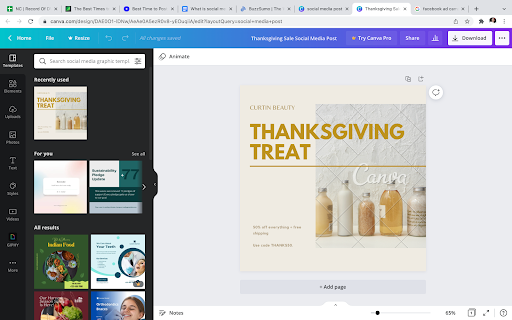
If you wish to create your own content but creating graphics or videos using high-tech tools seems like a task, these could be great options for you.
-
Canva
If you are not a graphic designer, worry not. Canva has made lives a lot easier for social media managers. This online tool comes packed with templates, icons, stock images, shapes, and more. You can adjust, resize, and reposition all the elements on your graphics easily. Canva has also recently launched its Animation feature, allowing you to make simple motion graphics.
-
InVideo.io
If you are looking for an easy-to-use yet powerful video editor, InVideo is one of the best out there. This tool also has plenty of templates, a music library, media, transition features, filters, and more, making it easy for you to edit videos and create beautiful montages for your business.
Calendar Creation
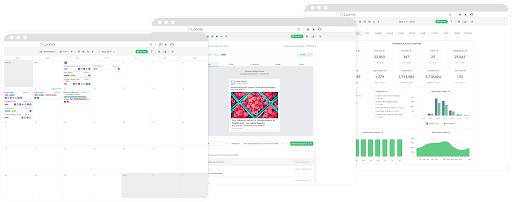
Creating calendars helps make sure you are on the right track and everything is posted on the right day. These are the tools to help you with the same.
-
Loomly
Loomly gives your entire team one platform to collaborate. This tool helps you move on from the old spreadsheets and manage your social content in one place. Everyone in your team can view calendars, add labels, and manage content assets.
-
Buffer
Apart from helping you plan, manage, and publish your content, this tool also provides social media analytics, manages customer engagement, and tracks the growth of your accounts.
Scheduling and Publishing
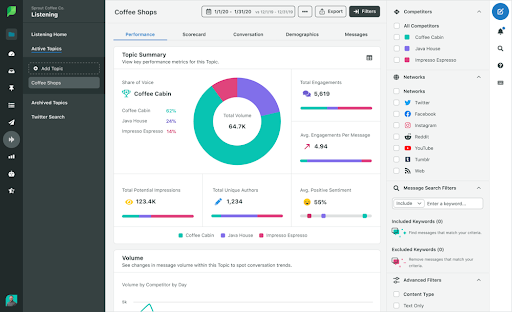
If you don’t have time to post on your chosen days, you can simply create your monthly content and upload them on the tools mentioned below. These tools will take care of the rest.
-
Hootsuite
Hootsuite is also an all-in-one social media tool, but it primarily makes it easier for you to manage your content once it has been created. With the tool, you can schedule your content as per your calendar, manage ads, and build a content library.
-
SproutSocial
SproutSocial is one of the most commonly used social media management tools. With the help of the tool, you can easily plan, schedule, manage, and deliver content across all social media platforms. This is also a tool you can use for social listening, customer engagement, and more.
Social Listening

Social listening tools are perfect to be at the right place at the right time.
-
Falcon.io
Tagged as the world’s leading social listening tool, Falcon.io helps you know what your customers and competitors are talking about your brand. You can even use the tool to spy on what your target audience is saying about your competitor’s brands and make informed decisions accordingly.
-
Keyhole
Keyhole allows you to track what people are saying about your brand in real-time, across different social media platforms. It also helps you generate detailed, one-click reports complete with sentiment analysis.
Community Management
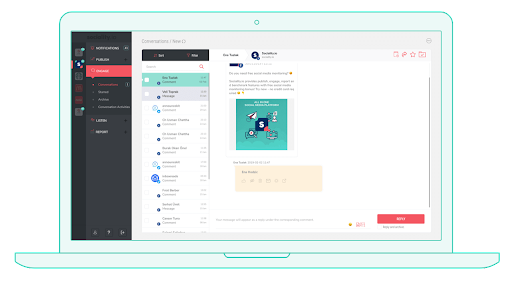
Community management or social CRM is when you blend your CRM software with your social media management. It helps you build better customer relationships and bring all your social notifications to one place. If you are ready to offer exemplary customer service to your customers, these tools are your go-to.
-
Sociality.io
This tool allows you to bring all the conversations with users in one spot. You don’t have to toggle between different tabs and accounts, which helps you ensure that all messages and conversations are wrapped up professionally. There are also several reply templates that you can use to make sure
-
Mention
‘Mention’ is an inclusive tool. It can track brand mention across almost 42 languages. You even have an option to tune out certain types of content that you wouldn’t like to see and only focus on trends. This tool has proven to show compatibility with Twitter, Instagram, Facebook, and Buffer.
Influencer Collaboration
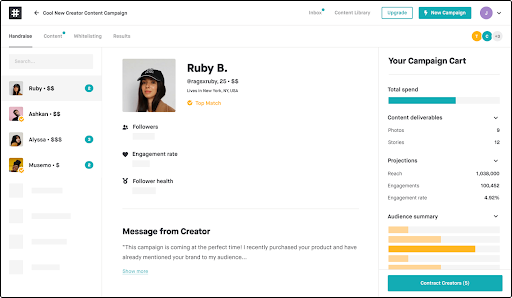
Finding the right influencers for your campaigns is important to see the desired results. Thankfully, there are now plenty of tools that can help you in this quest. The top two are given below.
paid
With this tool, you can find influencers and creators that truly love your brand. If you have someone who loves what you do, collaborating with them and depending on them to convince others in their social network is not as challenging. You can also analyze how your chosen influencer’s campaign is performing with the help of their insights.
Upfluence
Upfluence is an all-in-one influencer management platform that not only allows you to find creators for your brand but also manages influencer relationships.
Monitoring Performance
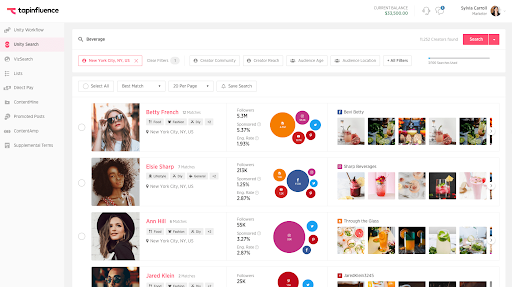
Monitoring tools make it easier to understand the insights, get detailed reports, and eventually make informed decisions. These are our top picks.
HubSpot
HubSpot offers analytics tools (including graphs and other visuals) that you can use to measure the performance of your social media marketing campaigns. The best thing about HubSpot is that you don’t have to use the tool for publishing content. You can use other publishing tools or publish on the go and integrate both.
TapInfluence
TapInfluence has been specially designed for your influencer marketing campaigns. From engagement to reach and potential budget that an influencer might request, you can monitor it all.
Take a look at your current social media approach: Audit
If you’re feeling like your social media presence has become stale, or you’re not getting the results you want, it’s time to re-evaluate what you’ve been doing and reassess your social media presence.
- Make a list of all the social media sites where you engage.
- Examine each social network.
- Choose which networks you want to keep.
- Update the Profiles.
- Examine your statistics to see if your strategy needs to be tweaked.
Identifying your target market

Identifying your target audience is equivalent to creating buyer personas for your company and will aid in the development of brand guidelines.
You’ll respond to questions like “Which content will your audience relate to?” and “What voice or tone should you use?” This is necessary so that you can communicate with your audience in the same language in social network management.
Selecting social media platforms
Your brand must be on the correct social media platforms for social media to create an impression. Each social media site has a distinct function, and users who log in to these networks utilize them in many different ways. You’ll be able to reach your target audience more effectively if you choose the correct social networking site for your brand and adapt your essential messaging for each.
Putting together your social media plan

A social media plan is like a checklist including all the things that you plan to do on social media and what your goals are. It gives you a direction towards achieving desired results and informs you if your plan is working or not. Your plan will be more effective if it is more personalized.
Making your social media profiles look good
It is a crucial step to follow. The profile should look tidy and attractive to the visitors. Make sure you are doing the following-
- Using the correct image size.
- Using high-quality photographs that are pleasing to the eye.
- Using the same profile photo across all social media platforms.
- Removing yourself from any images or postings that aren’t appropriate.
- Have filled in all of the fields.
Creating social media advertisements
Managing social media marketing also includes social media ads. An effective social media ad consists of several components. A social media manager can handle this task for you and ensure that your ads are successful across all platforms.
Creating a content calendar for social media
A social media calendar can save a lot of time and allow you to monitor and try different methods to determine which ones your audience responds to the most. It will save you time from scouring popular subjects and news items for ideas every day if you schedule posts ahead of time.
Creating social media content tailored to a given platform
One of the most common reasons for customers to unfollow businesses on social media is because of irrelevant content. If you tailor the content development process to the specific characteristics of each channel and its audiences, your brand will win a lot more. More participation and more conversions are guaranteed with tailored content.
Responding to messages on social media
Engage them in conversation, although not in a rehearsed way. Create natural conversation by being spontaneous. If someone compliments your work, don’t just thank them with a conversation-closing response; instead, answer with open-ended questions. Get them to talk.
Keeping an eye on your social media performance
Monitoring keeps you on track to meet your social media objectives, demonstrating what works and, more crucially, what doesn’t. Social media analytics tools can help you figure out where you’re performing and where you’re failing while also providing performance data to discuss with your colleagues, stakeholders, and boss.

Costs Involved In Social Media Management
The costs can vary depending on the type of social media involvement you’re searching for. However, there are a few elements that encompass the most important parts of managing social media.
- Hiring a skilled social media manager, freelancer, or agency.
- Tools for creating content, scheduling content, performance analytics & monitoring.
- Content creation (graphic design, motion graphics, video, copywriting)
- Spending on advertising (plus a management charge)
- You can also factor in the costs of collaborations, product giveaways, affiliate commissions, etc.
How Does Social Media Management Help Your Business?

Saving Time
Saving time is possible with properly managed social media by using suitable automation tools wherever possible. So, you do not need to spend 40-50 hours a week working on your social media strategy.
Customer Support Improvement
Customer support gets improved manifolds with Social media management. Customers get quick replies and solutions to their problems via social media.
Managing the reputation of your brand
When comments and messages go unanswered, it’s simple for customers to conclude you don’t care about them. This has the potential to sabotage a sale and, in the long term, a customer relationship. One of the most important advantages of social media management is how it ensures that no remark or direct message gets ignored.
Building authority
People regard you as a reputable and credible source of knowledge when they see your brand as an authority in your field. By appearing on social media feeds frequently, you boost your chances of getting seen and people become used to seeing your content.
Conclusion
In conclusion, we can say that social media management is not as easy as many might think. In this world of cut-throat competition, it takes patience, creativity, and a lot of effort to ensure that your social media presence is being maintained while making sure it adds value to the lives of the users.
As you must’ve read above, there is an entire process to develop a social media strategy, and implementing that strategy can get a little time-consuming, but the return on investment derived from it makes it worth the while.
Also, be careful when you are choosing your social media managers. They should be reliable, creative, and up-to-date with what’s trending. Only then will you have the chance of rising beyond the clutter.
FAQs
Why Is Social Media Management Important?
Social media over the years has grown exponentially, and here are some reasons why today it has become important:
- It increases brand awareness, as social media has an extensive pool of users, and with social media strategies, you can brand your business in front of potential customers by creating and sharing interesting, relevant, and engaging content.
- It drives traffic to your website, as when people come across engaging and interesting content, they want to know more about your business.
- It helps build relationships with your customers by making you more accessible to them. By responding to comments and messages, you can connect with your audience and be part of their conversation.
- Social media can also be used to generate leads by running social media ads. Alternatively, you can also focus on creating content that encourages people to get in touch with you or book a consultation appointment.
How Do I Become A Social Media Manager?
Being a social media manager is a fun and exciting way to stay updated with industry trends and help brands create relevant, informative, engaging content. Here is how you can do it:
- Learn the basics of social media marketing, starting from understanding different social media platforms, how they work, the nature of the target audience using the platform, and how to use these platforms to reach your target audience.
- Focus on developing skills, including copywriting, content creation, and social media analytics.
- Gain experience by working with companies that will give you the opportunity to explore social media marketing strategies and their related aspects. Having hands-on experience will build confidence, expand your portfolio, and give you the chance to put your learnings into action.





